By Lawrence Haywood, Mar 1, 2025
At this point in time, everything that could be said about Halong Bay has probably been said. The expansive stretch of limestone karsts jutting from placid waters reaches for 1,553km² from North-Eastern Vietnam into the Gulf of Tonkin, consisting of around 2,000 tree-topped islands that create a scene and atmosphere unlike anywhere else on earth.
It is not the mere numbers that turned Halong Bay into a UNESCO World Heritage Site in 1994, it is also the feeling of stepping back in time, of sailing through pre-historic waters, treading through ancient caves, and visiting islands that have remained steadfast through millions of years of activity.

Cruise in Halong Bay with V'Spirit Cruise
Many people say the south and north of Vietnam are like two completely separate countries, not least for the different food, people, dialects and approach to life, but also for the weather. Halong Bay’s weather patterns differ greatly from those in the south and middle of the country; perfectly sunny days in Halong Bay can happen at the same time as flash flooding in Ho Chi Minh City, while a clear and cool day in Da Nang could occur simultaneously with a tropical monsoon in Halong Bay.
There is much greater fluctuation in the northern weather of Vietnam than in the south, which is in a constant yearly battle between wet and dry. Halong Bay gets wet, absolutely, but has many other weather systems that add diversity and a completely different climate to the region. The best time to visit Halong Bay varies on factors like weather, activities, peak season versus off-season, prices, availability etc. Taking all of these factors into account, Incredible Asia Journeys is proud to present to you our conclusive look into the best time to visit Halong Bay.

Halong Bay Overview
>> Is it the Best Time to Visit Halong Bay? Certainly one of them, YES.
Spring in Halong Bay heralds the start of the tourist season in the region. April 2018 saw a staggering increase of 25% in international arrivals to Vietnam from the same period last year, while May saw a 20% increase, and most of these tourists make room for Halong Bay in their Vietnam itineraries. There’s no denying that Halong Bay is a premier tourist destination, and spring, being one of the best times to visit Halong Bay, is certainly one of the most profitable times for tour companies operating in the region.
Near-perfect weather in Halong Bay, with great visibility and relatively cool days. Mark your calender to book your cruise at this best time to visit Halong bay vietnam!
Though the mist of winter still hangs over Halong Bay on those March mornings, it doesn’t stick around for too long into spring, usually dissipating by April and bestowing unto visitors the perfect Halong Bay scene. 8 hours of sunshine per day is the average during the spring months, meaning that photos will be largely unblemished by any dark clouds and time out on the sundeck should be maximised.
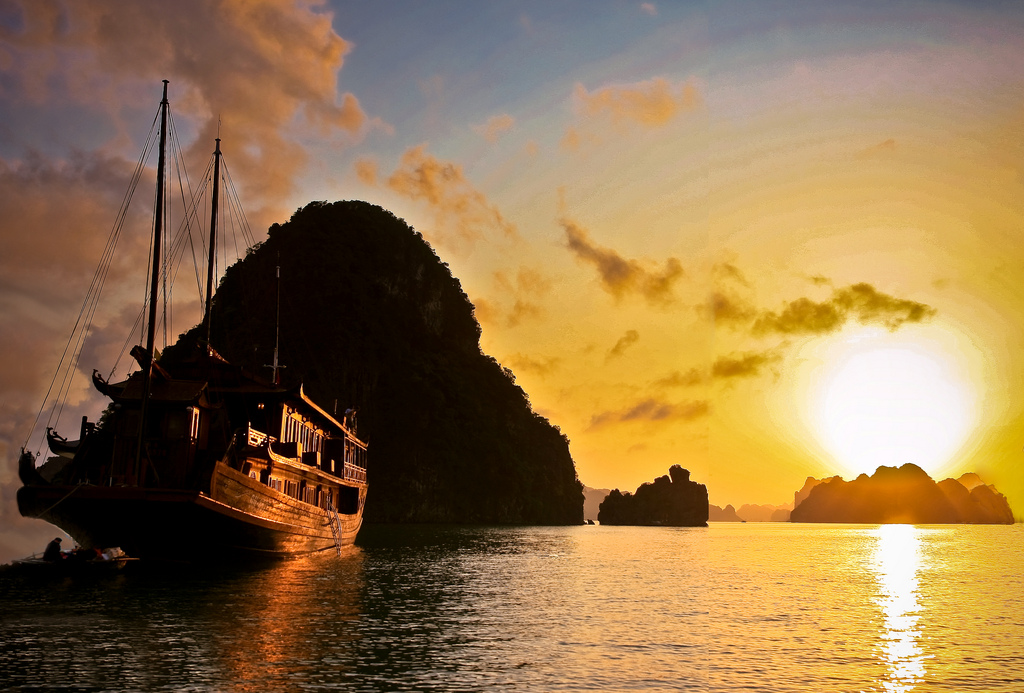
Sunset in Halong Bay in Spring
Average temperatures soar from 20°C (68°F) in March to 28°C (83°F) in May, with lows of 18°C (64°F) and highs of 30°C (86°F) in between. May averages just one degree below the hottest month of June, and the Mother Dragon’s preparation for the oppressive heat of summer can be felt towards the final weeks of May. A swim is a good alternative to sitting in the baking sun, as water temperatures are a cool 27°C (80°F).
The placid clouds around Halong Bay in March and April pose very little threat to tourists’ good times. Both months hover around the 55mm level of precipitation, with at least some rain making an appearance on 26 days out of 61. However, the wrath of the wet season begins towards the middle of May, when 55mm shoots up to 170mm in the blink of an eye. Only 14 of the days in May feature rain, but they feature it with much more ferocity than the previous two months.
While tourist numbers are high during the start of spring, they dip dramatically towards the end, precisely because of the monsoon-related reason mentioned above. Overall international tourism to Vietnam dives towards the latter days of May as clouds congregate and sporadic deluges become more and more common. Arguably, this is the best time to visit Halong Bay for two reasons: off-peak cruises starting in May are much cheaper and you will have a lot more space to yourself on the boat and on excursions; and photo opportunities of dark, rolling clouds make perfect snapshots of South-East Asia’s temperamental weather system.
Tourist high season – more expensive tours and more crowded attractions.
- As far as clothing is concerned, you shouldn’t need anything other than light, airy clothes. Nights only dip as low as 18°C in spring, so save the woolly pyjamas for winter.
- Lots of sun cream for all of those days spent out on the sundeck and on various beaches soaking up the 8 hours of sun per day.
- An umbrella, both for the Western purpose of rain deflection and the Asian purpose of sun ray deflection; an umbrella could be your best friend in Halong Bay.
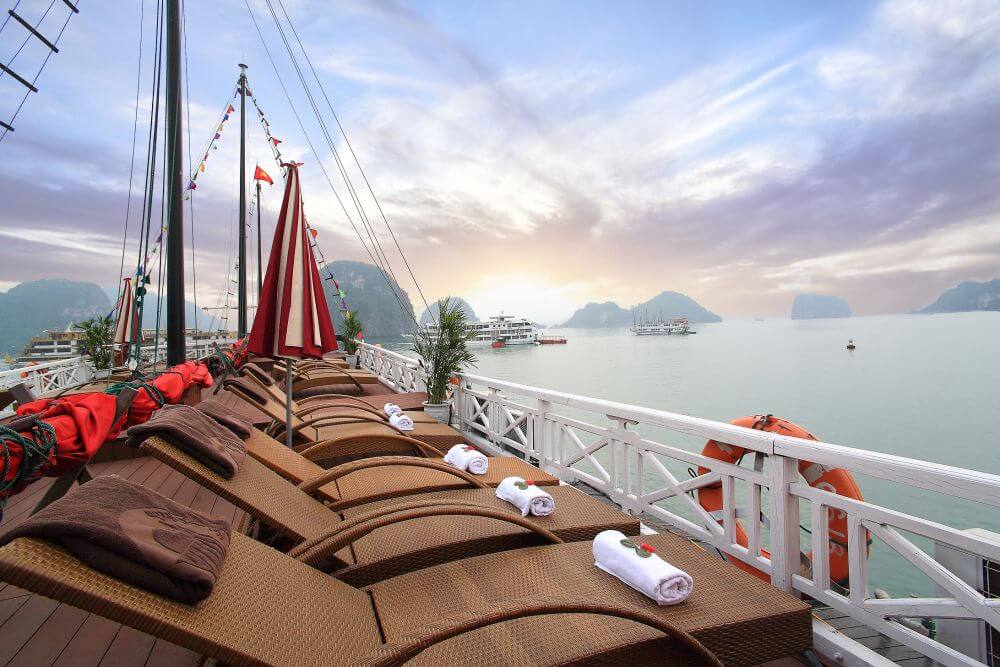
Halong Bay from Cruise's Sundeck
>> Is it the Best Time to Visit Halong Bay? For fish, perhaps, not for humans.
Usually linked to the idea of good times and long days outdoors, summer in the West is just a little different to summer in Northern Vietnam. The only reason that you would spend long days outdoors in Halong Bay during summer is if you felt like learning to swim on the sundeck. In other words, it’s wet. Very wet. While it may not be the best time to visit Halong Bay for the weather, trips to the World Heritage site during this time can offer you a very unique perspective into rural life during the storms.
Smaller crowds, better prices, lots of time for contemplation.
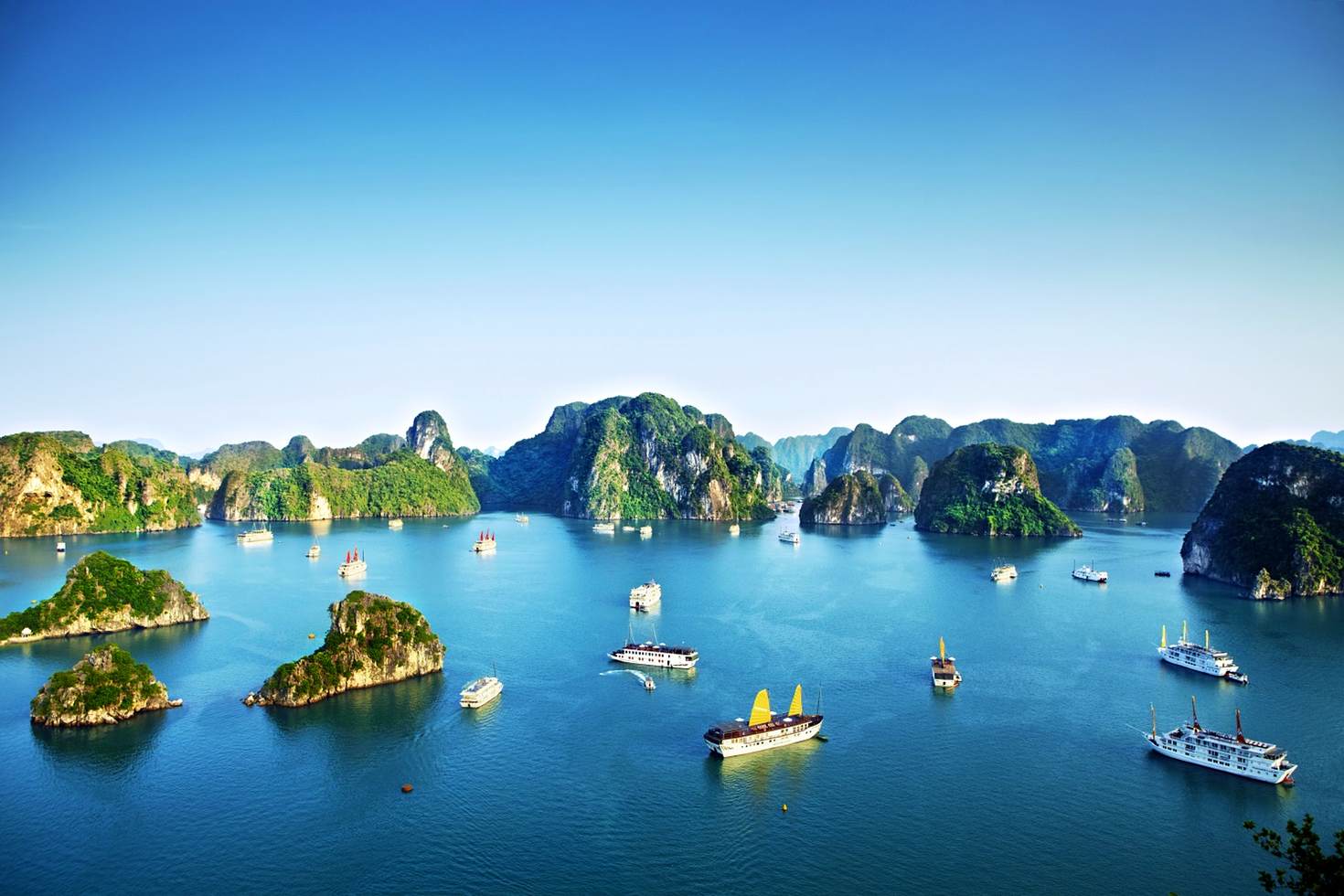
Halong Bay in Summer
Here’s the first positive for the start of the off-season: sunshine hours remain fairly constant at an average of 7 per day over the course of summer. While most visitors would expect more cloud coverage during the wet season, clouds tend to roll in, shed their incredible watery hauls and roll out pretty quickly. This still means plenty of time for sunbathing and some amazing photos of blue skies with mischievous storm clouds in the background. August is one of the months year-round with the lowest sunshine hours at 6 per day, but this is not much of a change from the months with the most blue skies, such as June, which features 8.
One of the big kickers during the wet season; the heat brought on by summer is universal, but the heat brought on by a Vietnamese summer can be overbearing. 32°C (89°F) is the regular high reached in August, which can be somewhat stifling, and lows of 24°C (75°F) at the start and the end of the season are the best that you can hope for. However, one of the wonders of the rain is that temperatures do plummet during and after a storm, leading to much cooler weather around Halong Bay as the clouds above it part ways.
In reality, the rain is one of the few things stopping summer from being among the best times to visit Halong Bay. It is a phenomenon that puts a lot of people off visiting Halong Bay and Vietnam in general, but the rain gets a much worse reputation than it deserves. Deluges of rain are, in actual fact, unabashedly fun; there are few feelings more liberating than standing out in a Vietnamese rainstorm and soaking in the sounds and the tranquil atmosphere, amplified many times by the natural splendor of Halong Bay. You will certainly have a wealth of opportunities to try this out, as August reaches about 265mm of rainfall over the course of 16 days. June is the driest month of summer at a relatively barren 172mm, but if you have/decide to visit Halong Bay during summer, you should try your best to be open-minded and embrace the wonder of the Descending Dragon’s rainy nature.
As you might imagine, most international tourists are put off by the wet season without fully knowing how it works. Domestic tourists are more well-informed and head to Halong Bay during early June once the school year is finished. There are still plenty of beautiful days to be savoured at this time and domestic tourists like to take advantage of the dip in overseas interest. Day tours are very popular with the Vietnamese but there are always quite a few cabins left on the overnight and 3-day 2-night tours, giving you a chance to claim a fantastic price on an off-season promotion.
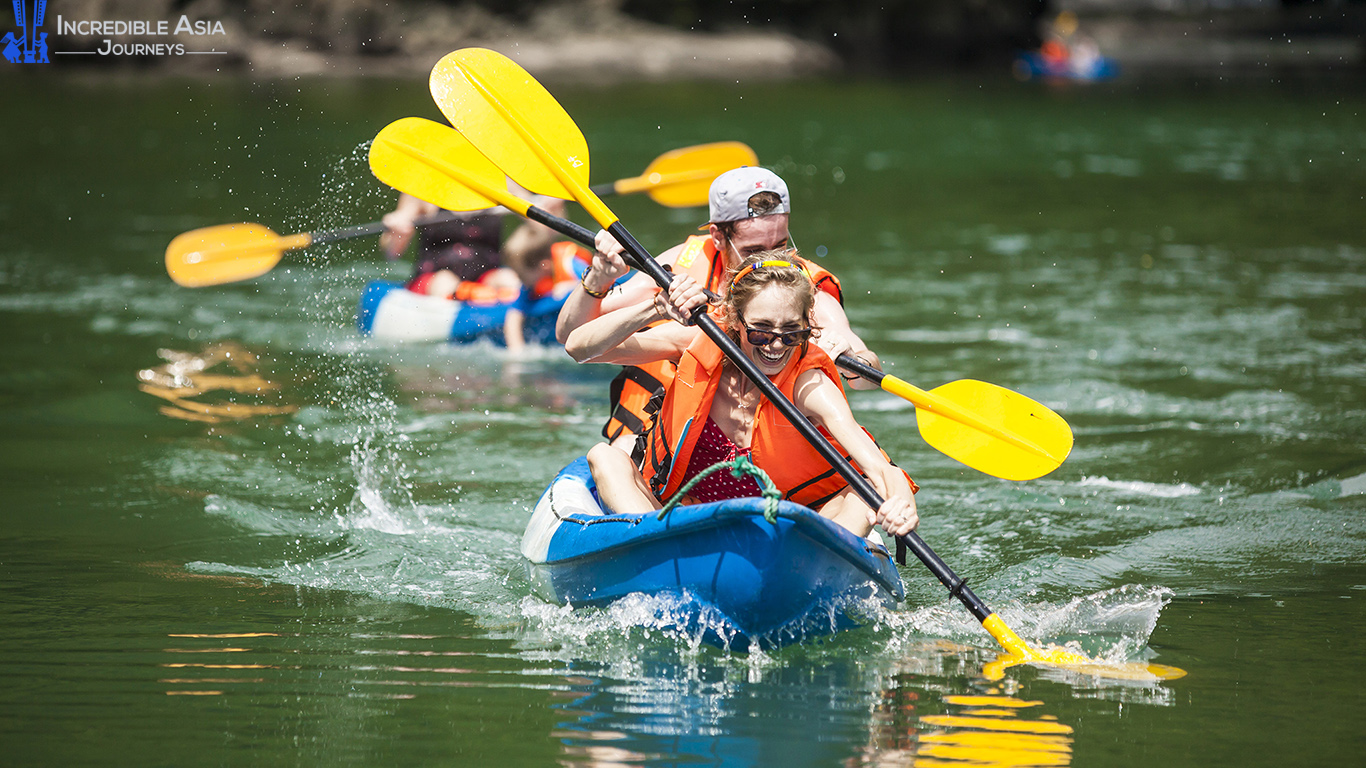
Tourists in Halong Bay in Summer - Kayaking in Halong Bay
Long periods of torrential rain and sweltering temperatures.
- Depending on how much you want to live like a local, you need to bring either an umbrella or a Vietnamese rain poncho, preferably both considering the power and amount of rain that will be falling.
- A book, for any extended periods of time that you have to spend in your cabin.
- A camera. Halong Bay carries an ethereal beauty before, during and after a rainstorm and you’ll want to capture those moments while you can.
Check out the top-rated & best Halong Bay cruises:
>> Is it the Best Time to Visit Halong Bay? If you can withstand the mass tourism, absolutely.
This period is considered Halong Bay cruise best time to visit.The rainclouds make way for the tourists during autumn in Halong Bay, who again descend on the region in search of picture-perfect weather and comfortable excursions out on the water, on beaches, and in the caves. They find it, too, as autumn is absolutely the best time to visit Halong Bay for its perfect weather. It is the shortest period in the year, so it is likely to be full of tourists who are trying to cram in a Halong Bay holiday before the mist of winter rolls in.
Amazing weather, great photo opportunities, and a good atmosphere.
Bright and blue for most of the time during autumn, Halong Bay shines during this season with 7 to 8 hours of sunshine per day and very little threat of rain. The sun ducks behind the cloud during the latter stages of November, preparing itself for a more shrouded winter. Excursions to islands with beaches like Titop and Ban Chan become very popular for people looking to claim a tan, and the sundeck becomes a number one spot on the cruise as Halong Bay’s weather graces even the whitest skin with a chance of becoming golden brown.
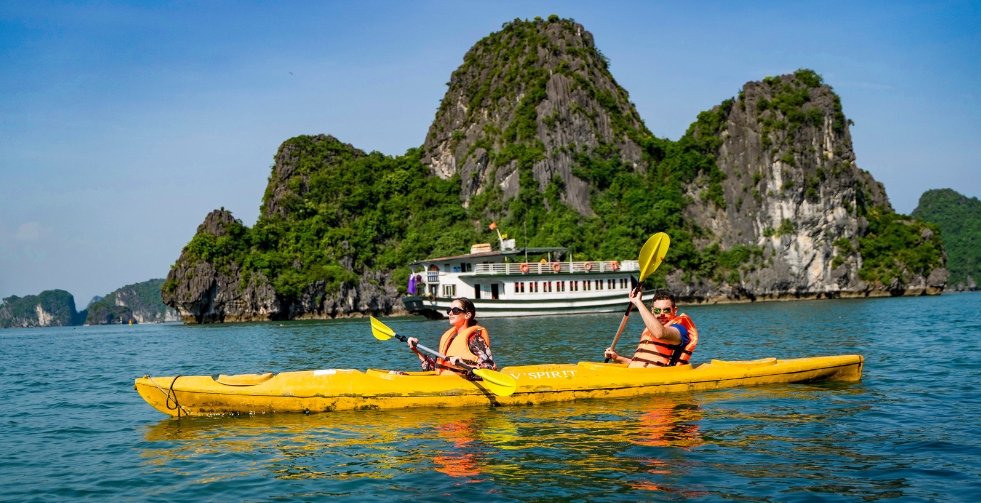
Halong Bay in Autumn with bright and blue sky
The rain clouds wash away the last of Halong Bay’s summer heat, clearing the way for a cool and less humid autumn. Temperatures fall from 28°C (82°F) to about 22°C (72°F) over the course of September to November, making kayaking expeditions and climbs to the tops of caves and peaks much less of an energy-sapping experience. Much like spring, the lowest temperature reached in autumn is 18°C (64°F), which is certainly not uncomfortable for Western tourists, but Asian tourists used to higher temperatures might want to consider a thin sweater.
Having shed 80% of its yearly rainfall during the summer months, Halong Bay is in a more placid mood come October, when the 190mm of rainfall becomes 54mm. If this isn’t shocking enough of a comparison from the 265mm that falls just two months prior, then consider that November gets a paltry 12mm and is the second driest month in the year. Again, this spells fantastic opportunities for excursions and time on the sundeck, as barely even the threat of light rain draws guests out of their cabins and out into the clear blue sky.
Always the biggest drawback of the perfect weather; the tourists come in droves during autumn, creating queues for caves, overcrowding floating villages, and taking up places on the cruise’s sundeck. This is usually the time when tour companies advise alternative trips to any of Halong Bay’s satellite bays, Lan Ha Bay and Bai Tu Long Bay, both stunning examples of the same labyrinthine karst scenery, sandy beaches and mysterious caves, but without the tourist hordes.
Prime season for tourists, queues form for the more popular caves and islands.
- Breezy clothes are again the best to bring for the warm-but-not-too-warm months. Flip flops are also a good idea to fully soak up the relaxed atmosphere that enraptures Halong Bay.
- Days are long and bright, so remember sunglasses, sun cream, and a hat.
- While excursions are likely to be crowded, you can opt to spend that allotted time on the sundeck by yourself, so bring a book and plenty of cocktail cash for your own private party.
Check out our best tour of Halong Bay:
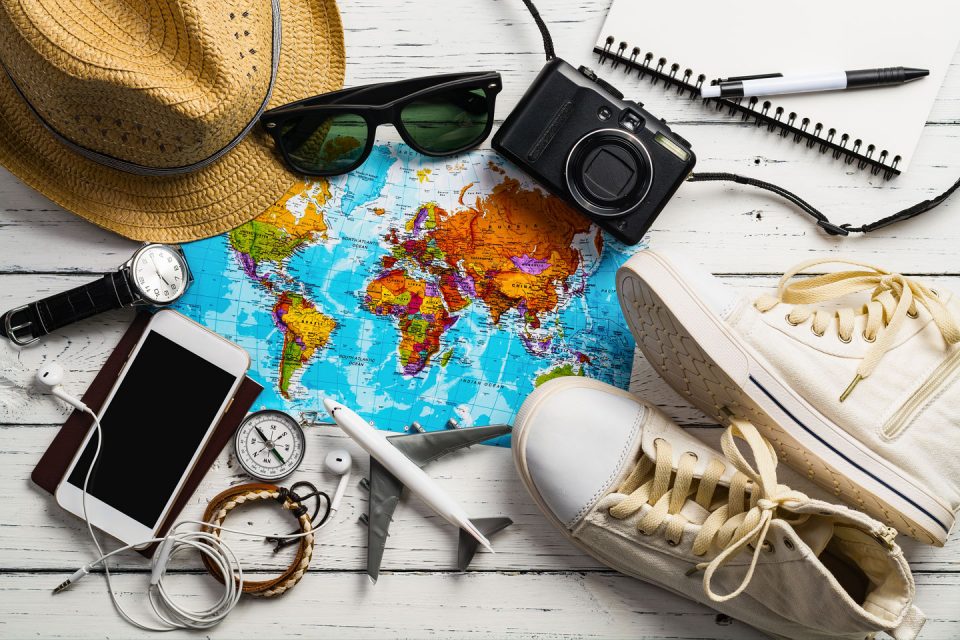
Things to bring when cruising in Halong Bay
>> Is it the Best Time to Visit Halong Bay? Definitely not, but there’s a joy to be had.
The topography of Halong Bay during winter bestows a very Jurassic atmosphere in the area. This is because of the famous fog that encircles the bay, seeping through gaps between forested mountains and settling around cruise paths, shrouding all of Halong Bay in a thick haze, limiting vision but maximizing the sense of wonder felt by the few passengers who take the opportunity to see it.
The ethereal beauty that befalls Halong Bay, and the lack of tourists there to see it.
So, have you found out when to visit Halong bay? Let's move to Halong Bay in winter! Realistically, you’re going to get some fog on any overnight tour of Halong Bay during winter. Some tour companies claim that this is the best time to visit Halong Bay because of the eerie atmosphere that the fog creates, and, while it does have its charms, it gets tiresome before long and generally pales in comparison to the clear skies of spring and autumn. However, 5 hours of sunshine per day during this period is pretty standard, meaning there is still a good chance that you’ll get a decent time on the sundeck, even if you can only see the silhouettes of shrouded peaks in front of you.
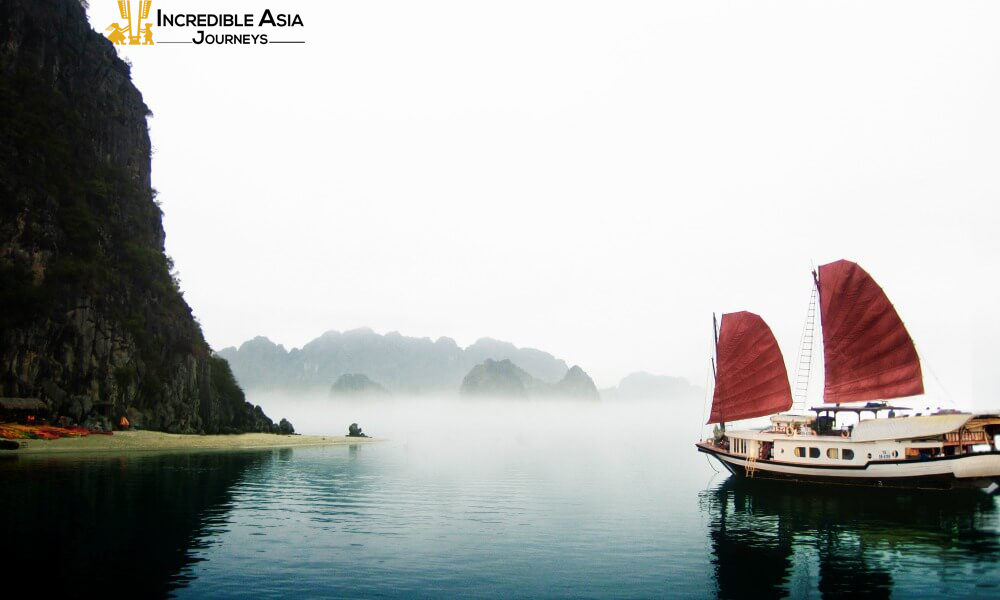
Halong in the Winter
This is an area of some dispute depending on where you’re from. Averages for winter dip below the 20°C mark, with temperatures more regularly reading about 18°C (64°F) with very little variation between December and February. This is quite an acceptable temperature for most Westerners, who doggedly arrive in Halong Bay in their flip-flops and shorts, determined to make the most of their holiday even in mildly cold weather. Vietnamese and other Asian tourists like to take a more conservative approach, donning many layers of clothing to keep what they consider a bitter chill at bay. Nights can reach as low as 14°C (57°F), meaning long evenings out on the sundeck might need to withdraw to the bar or cabin sooner than expected.
The fury of the summer rains has long passed Halong Bay and the land of the Descending Dragon is in a much more docile mood come December. If 23mm of rainfall sounds like a dry experience, then wait until January, when monthly rainfall falls to an arid 3mm. It’s safe to say that you won’t need much in the way of wet weather gear, but be aware that January’s minimal rain still falls over the course of 10 days, providing a third of the month with something you would class as speckles of moisture in the cloud rather than rain.
What tourists? While Halong Bay is far from deserted during the winter, you’ll see notably fewer cruises on the water, and not just because you can’t see your own feet in the fog. You will have a lot more freedom on excursions to islands and around fishing villages, as even the guests who tour Halong Bay opt for a warmer, contemplative stay in the cabin. Caves remain relatively warm during winter so it’s still possible that visits to Thien Canh Son and Me Cung will be mildly busy, but nothing like the rush to claim their naturally cool air during the hot weather of spring, summer and autumn. Winter is most definitely the off-season, giving you the opportunity to claim great deals on cruises, and splashing out on a luxury cruise might be an idea considering how much time you will spend on board during the winter.

Tourists in Halong in Winter
It’s colder and mistier than ever before.
- Personal entertainment like a book, laptop, and deck of cards would be a good idea for those long days on the boat.
- A camera, to capture the majesty of Halong Bay fog and for the hazy sunrise and sunset that happens each day.
- Some cold weather gear, maybe just a few thin jackets and comfortable closed shoes for when the sun descends behind the limestone karsts.
The steep angles and sheer rock faces of Halong Bay’s islands and mountains were created in primordial times, about 500 million years ago. Movement in the tectonic plates pushed limestone spires from the ocean floor high into the sky, and here they still stand, as proud sentries over the lapping waters of Halong Bay.
Rain erosion began to take its toll on the islands about 70,000 years ago, contouring them into distinctive shapes and bringing about some of the wonderful legends told by locals living on Halong Bay’s waters for generations.
The earliest years of habitation in Halong Bay stretch back about 200 centuries. The initial activities of fishing and fruit collection were supplemented by the creation of pottery, stone tools and the ability to trade with other cultures around Vietnam and China.

Vung Vieng Fishing Village
Floating villages like Vung Vieng and Cua Van became hubs of the fishing trade, quickly growing to the point where colorful residential houses developed connections via bamboo walkways. Small shops, schools, and even police stations popped up around the anchored villages and, once tourism started in the region, these communities became very popular for the idyllic, uncomplicated existences in which they operated.
Tourism started as far back as the 19th century under French occupation, with exclusively French expeditions to Halong Bay bringing back many wonderful stories of the area to Hanoi. President Ho Chi Minh and his Russian cosmonaut friend Gherman Titov visited the area in 1962, launching it into the national limelight after the president named one of Halong Bay’s now-famous islands after his fellow communists.
20,000 years of human habitation in Halong Bay has given rise to some wonderful, whimsical stories about the formation of its islands and caves. ‘Ha Long’ translates to ‘descending dragon’, named for the Mother Dragon and her children who defended the area against naval invaders by firing clumps of emerald out of their mouths to sink enemy ships. Upon hitting the water, these emeralds became the limestone karsts dotted around Halong Bay, and are today a constant reminder of the Mother Dragon’s power and love for her homeland, something that crops up in a multitude of other ‘Dragon vs China’ tales from around the country.
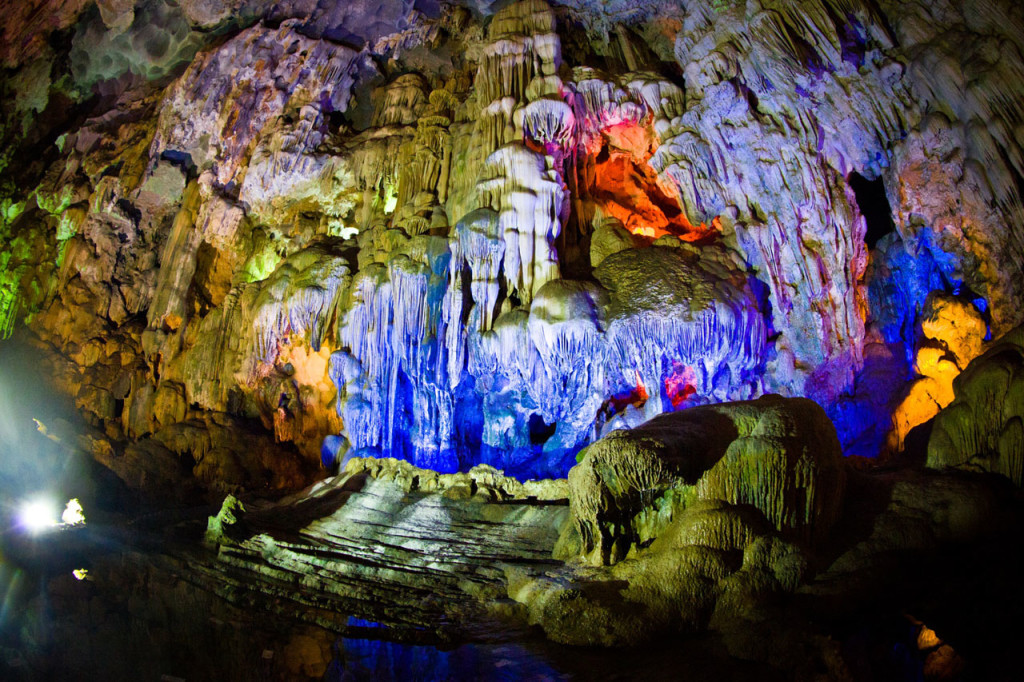
Thien Cung Cave
The habitation of caves also brought about several of its own legends, owing to the many different shapes of stalagmites and stalactites formed over tens of thousands of years. Thien Cung Cave is perhaps the most imaginative example of this, featuring the Dragon King and his human wife, May, whose week-long wedding ceremony was attended by one of every animal in the animal kingdom as well as a few gods. The couple raised a staggeringly large family within the cave, eventually splitting the family down the middle when May decided to take 50 of their 100 kids to new lands while the Dragon King remained behind with the other 50 to improve the lives of the mortals in Halong Bay. Along with the stone remains of all of their wedding guests, Thien Cung Cave is littered with stalagmites imaginatively said to resemble the Dragon King and his offspring.
Almost half of the 2,000 islands of Halong Bay are named in similar fashion and locals are happy to share with you the stories of the ones that they remember.
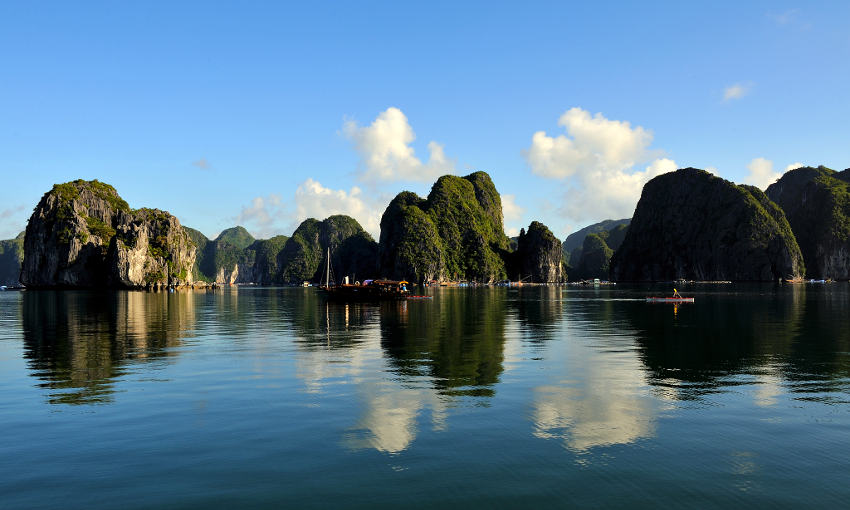
Bai Tu Long Bay - Child Dragon
Halong Bay’s more recent international recognition is due to the largely unchanged nature of the region over its thousands of years of human habitation. Floating villages operate much in the same fashion that they did when they were established 20,000 years ago, and the hardy cliffs speckled around the bay still offer much scope for exploration and scientific discovery.
It was inducted into UNESCO’s World Heritage list in 1994 for the outstanding nature of its limestone towers, and again in 2000 for its fascinating and otherworldly cave systems. Halong Bay’s incredible preservation over millions of years earned it its first accolade in 1962 from the Ministry of Culture, Sport and Tourism and its most recent in 2012, when it joined the Amazon Rainforest, Iguazu Falls, and Table Mountain as one of the New 7 Wonders of Nature.